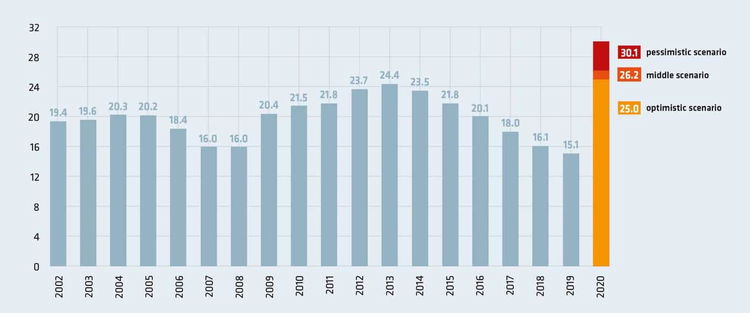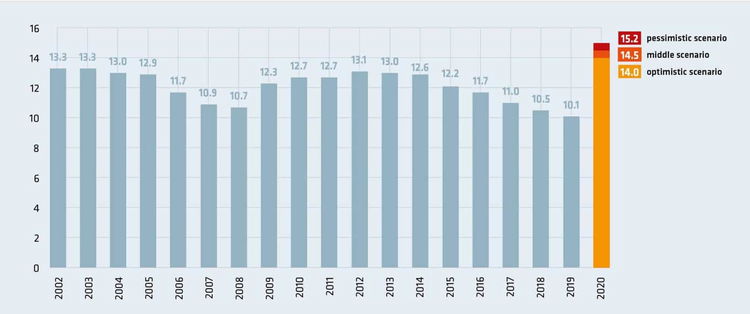The Youth Guarantee has failed to deliver on its promise. The deepening economic crisis makes a well-functioning guarantee even more imperative.

The shutdown of the economy to avoid the coronavirus spreading rapidly has led to skyrocketing unemployment in most countries. The especially difficult labour-market situation for young people has however rarely been recognised. Yet, according to our estimates, youth unemployment will increase by around 70 per cent within one year. We propose a new European Youth Guarantee, with sufficient funding of €50 billion, to ensure that those countries which suffer the most economically are relieved.

Youth unemployment and general economic developments are highly correlated. On the basis of the experience of the Great Recession (2008), we assume that a decrease in gross domestic product by 1 per cent leads, ceteris paribus, to a decrease in youth employment of 1.77 per cent. In the current downturn, the International Monetary Fund assumes a reduction in real GDP of 6.6 per cent in Europe for the year 2020. The European Commission’s spring forecast predicts an even stronger fall of 7.4 per cent in real GDP in the European Union.
We use these two prognoses, as an optimistic (IMF) and a middle (commission) scenario respectively, to calculate the impact on the youth labour market. Due to the considerable uncertainties, however, we add a third—pessimistic—scenario of a 10 per cent slump in real GDP for the EU27.
Drastic impact
If the predicted recession becomes a reality, the impact on young people will be drastic. In our middle scenario, youth unemployment would increase from 2.8 to 4.8 million. The youth unemployment rate would rise to 26 per cent (figure 1), meaning that one in every four young people who wanted to work would be unable to find a job. By our estimates, the number of those not in education, employment or training (NEETs) would increase from 4.9 to 6.7 million, or one in every seven young people in the EU (figure 2).
Figure 1: trend in youth unemployment rate, EU-27 (%), and forecasts

Figure 2: trend in NEET rate, EU-27 (%), and forecasts

Because of the Great Recession, the EU introduced a Youth Guarantee scheme in 2013 to ensure that all young people would receive an offer of employment or continued education, within four months of becoming unemployed. The Youth Employment Initiative was the main EU funding programme, with a total budget of €6.4 billion for six years.
Even though the aim of the European Youth Guarantee was reasonable, its implementation has caused problems, mainly because of insufficient funding. The essential costs of an effective Youth Guarantee are estimated at between €45.4 billion and €50.4 billion per year.
If policy-makers now intend to provide adequate total funding for a new European Youth Guarantee, they have to ensure, on the one hand, that it is principally financed by the EU budget on a basis of solidarity and, on the other, that member states contribute according to financial capacity. The latest proposals from the European Commission for a recovery fund include this distribution idea.
The proposed budget of €750 billion is impressive but there should be a clear focus on young people and more fresh money is needed immediately (before the autumn) if youth unemployment is to be reduced. Therefore we propose a new fund endowed with €50 billion, including quickly utilising REACT-EU funding as the commission has itself suggested. With reference to our prediction (middle scenario), the fund would guarantee that on average €10,400 is available for each unemployed young person (see table).
Parameters of the suggested Youth Guarantee
| Optimistic scenario | Middle scenario | Pessimistic scenario | |
| Overall fund | €50bn | €50bn | €50bn |
| EU contribution (2/3) | €33.5bn | €33.5bn | €33.5bn |
| Member states (1/3) | €16.5bn | €16.5bn | €16.5bn |
| Number of unemployed youth | 4.57m | 4.8m | 5.49m |
| Number of NEETs | 6.49m | 6.71m | 7.06m |
| Funding per unemployed youth | €11,000pa | €10,400pa | €9,100pa |
| Funding per NEET youth | €7,700pa | €7,500pa | €7,100pa |
The fund should be financed two-thirds overall by the EU, with the member states co-financing the remainder. To guarantee solidarity and to avoid a possible free-rider problem, EU financing should be higher if the pandemic results in a higher increase in youth unemployment in a member state than elsewhere, falling (notionally) to zero were that increase to be zero.
It might be useful to integrate additional social and economic factors, such as the incidence of poverty and public debt, as co-financing factors: member states enduring greater poverty and/or debt should co-finance less, because of their restricted opportunities. Our concept is based on ideas of formula-based financing, as used in educational systems to balance capacities and needs. More equity and transparency are important advantages of formula-based financing.
A new European Youth Guarantee would not only signal that the EU cares about the next generation, but also that it is keen to support economically and financially struggling regions. For those unemployed young people who have already been awarded a qualification, the Youth Guarantee should also be a Job Guarantee, meaning that young people would gain their first experience of employment in the public or the non-profit sector.
This would not only benefit the young people concerned. Society as a whole would benefit from the socially and ecologically useful products or services to which they contributed.
Dennis Tamesberger is a labour-market expert at the Chamber of Labour in Linz, Austria and was a lecturer at the Johannes Kepler University of Linz. Johann Bacher is professor of sociology and empirical social research at JKU and scientific director of the Institute of Vocational and Adult Education.